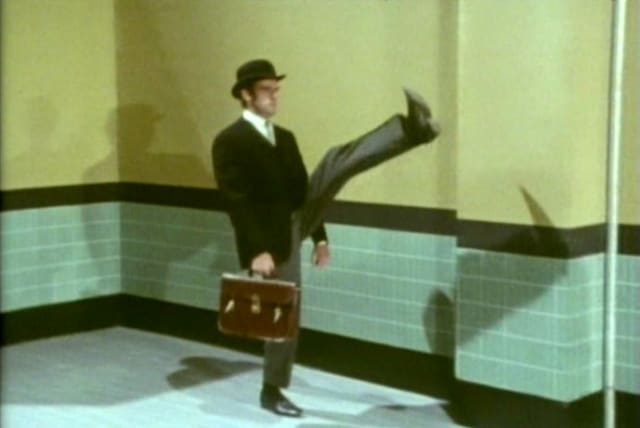Monty Python's 'silly walks' an easy way to be active, healthy - study

The study, led by researchers from the US, sheds light on a possible solution for stagnant global inactivity levels, all with a fun Monty Python twist.
If everyone would take the time to to walk in a silly an inefficient manner as shown in an iconic 1970 Monty Python for just a few minutes each day, it can help the world reach global physical activity targets, a new study has found.
The findings of this study, fun facts of which can be found here, were published in the Christmas issue of the peer-reviewed academic journal The BMJ.
The study, led by researchers from the US, sheds light on a possible solution for stagnant global inactivity levels, all with a fun Monty Python twist.
And now for something completely different: Global inactivity levels and why they happen
Physical inactivity is defined by the World Health Organization (WHO) as being less than 150 minutes of moderate intensity activity on a weekly basis.
For the past 20 years, global levels of physical inactivity have stayed completely stagnant, not getting any better. Meanwhile, cardiovascular has become twice as prevalent since 1990 and obesity has become three times a prevalent in the US and Europe.
So why is this happening?
For starters, there are a vast number of barriers in place that seem to impair physical activity.
These include, but are not limited to:
- A lack of safe and accessible public recreation spaces
- Transportation infrastructure
- Urban planning
- Restrictive social norms
However, there is another barrier that is far more evolutionary-centered that tries to ensure that we as humans do as little physical activity as possible. This neuro-physiological and psychological phenomenon is known as TEMPA, the theory of effort minimization in physical activity.
So how do we counter this?
This new study seems to have found a solution in the form of what it calls "the so far unrecognized scientific genius of Monty Python's Ministry of Silly Walks (MoSW)."
What is the Ministry of Silly Walks?
For those unfamiliar, the Ministry of Silly Walks is a Monty Python sketch from 1970 and was meant to satirize and poke fun at the inefficiency of government bureaucracy.
It centers on a fictitious ministry within the British government that is devoted to the development of silly walks, aided by grant funds and budgets of the same amount as what is provided to the fellow ministries of Health, Education, Defense, Housing and so on.
The sketch follows the characters of Mr. Teabag and Mr. Putey, played by John Cleese and Michael Palin respectively, with their absurd and inefficient silly walks on full display - though of course, as noted by Teabag, Putey's silly walk is a bit problematic because "the right leg isn't silly at all, and the left leg merely does a forward aerial half-turn every alternate step."
Half a century later, the Ministry of Silly Walks has gone on to be one on of the legendary British comedy troupe's most famous and beloved sketches, and even sparked the creation of an official mobile game adaptation back in 2014.
During the COVID-19 pandemic, one family even marked off the sidewalk by their home as a designated spot for people to do silly walks in the same vein as the Ministry of Silly Walks, recording it via doorbell cam and uploading it to Instagram.
View this post on Instagram
More importantly though, the iconic Monty Python sketch is the foundation of the researchers' solution to the TEMPA problem: PEMPA, practice of effort maximization in physical activity.
The idea is that silly walks are inherently inefficient. This is important, because humans have evolved to move in energy efficient ways. This means that the way humans move are inherently meant to be done while using as little energy as possible.
In other words, silly walks, by being inherently inefficient, would expend far more energy.
With that in mind, it was all a matter of testing it.
First, it was necessary to figure out what kind of silly walk was the most inefficient, and therefore the best for PEMBA.
Amazingly, there has already been biomechanical analysis on the Monty Python sketch. The conclusion was that Mr. Teabag's sily walk was 6.7 times more variable than normal walking, while Putey's was just 3.3 times more variable, implying that John Cleese's character was correct when he said that Palin's character's walk wasn't that silly at all.
But in terms of energy expenditure, there is a severe lacking in scientific literature on the most inefficient and energy costly form of silly walking.
So, the researchers had to figure it out themselves.
Ultimately, the researchers had to figure out oxygen update, energy expenditure and exercise intensity, the latter of which is the amount of calories expended per minute of activity.
Overall, the result was that the Teabag silly walk was not only the sillier, but it also was the best at being the worst.
The researcher found that the Teabag silly walk expended 2.5 times the amount of energy of regular walking and had a significant rise in oxygen uptake, which qualifies as vigorous intensity exercise.
Doing the Teabag silly walk for just a minute saw a signfiicant eise in calorie expenditure.
To put it simply, just 11 minutes of the Teabag style silly walk each day will lead to 75 minutes of vigorous intensity physical activity per week.
All of this comes with considerable benefits, and all without needing extra time commitments.
Now admittedly, this was a small study and it can't yet be endorsed for use by the general public, especially when compared to other forms of exercise.
However, it does show that clearly, there is more to walking in a ridiculous manner than simply walking in a ridiculous manner. Inefficiency may very well be the way to go.
It seems Monty Python, in an attempt to satirize government bureaucratic inefficiency with the Ministry of Silly Walks, may have touched upon something brilliant that could prove to be extremely helpful, and had doctors taken it seriously back in the 1970s, the world might be a healthier place.
Maybe the British government should fund the Ministry of Silly Walks after all.
Jerusalem Post Store
`; document.getElementById("linkPremium").innerHTML = cont; var divWithLink = document.getElementById("premium-link"); if (divWithLink !== null && divWithLink !== 'undefined') { divWithLink.style.border = "solid 1px #cb0f3e"; divWithLink.style.textAlign = "center"; divWithLink.style.marginBottom = "15px"; divWithLink.style.marginTop = "15px"; divWithLink.style.width = "100%"; divWithLink.style.backgroundColor = "#122952"; divWithLink.style.color = "#ffffff"; divWithLink.style.lineHeight = "1.5"; } } (function (v, i) { });

